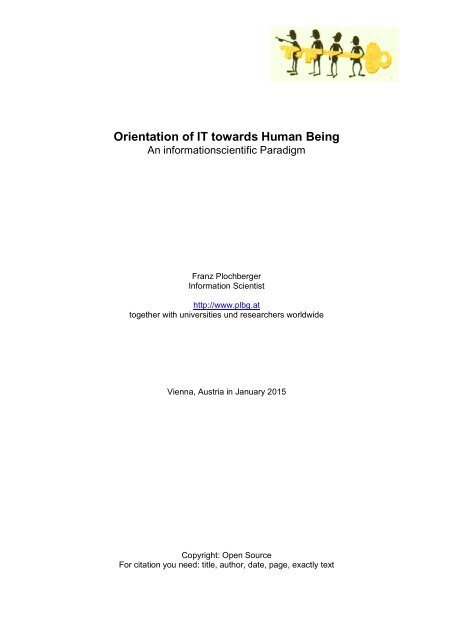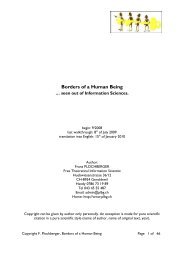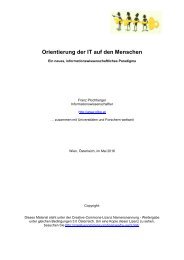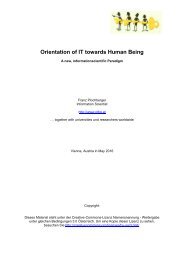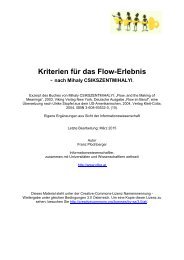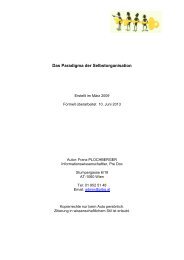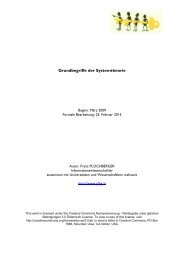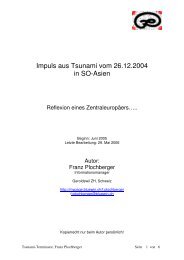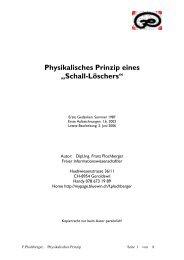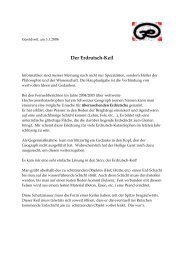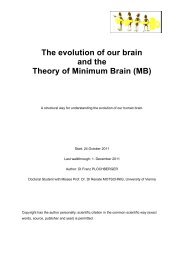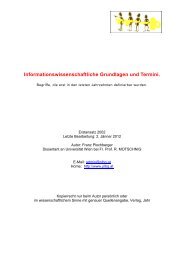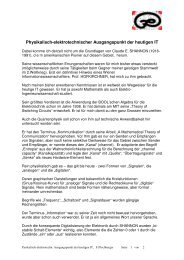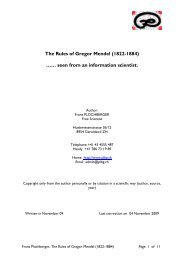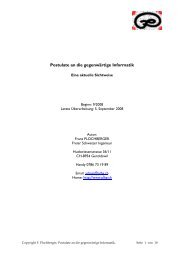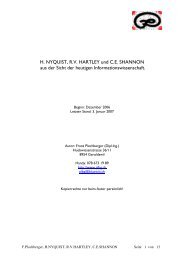Orientation of IT towards Human Being (2015)
Create successful ePaper yourself
Turn your PDF publications into a flip-book with our unique Google optimized e-Paper software.
<strong>Orientation</strong> <strong>of</strong> <strong>IT</strong> <strong>towards</strong> <strong>Human</strong> <strong>Being</strong><br />
An informationscientific Paradigm<br />
Franz Plochberger<br />
Information Scientist<br />
http://www.plbg.at<br />
together with universities und researchers worldwide<br />
Vienna, Austria in January <strong>2015</strong><br />
Copyright: Open Source<br />
For citation you need: title, author, date, page, exactly text
“Even if you see a very high mountain before you - for climbing on a difficult way - you<br />
start by o n e step.”<br />
(old wisdom)<br />
For my daughters Clara and Isabelle!<br />
©Franz Plochberger (2014), <strong>Orientation</strong> <strong>of</strong> <strong>IT</strong> <strong>towards</strong> <strong>Human</strong> <strong>Being</strong> (<strong>2015</strong>), page 2 <strong>of</strong> 23
1. Abstract<br />
Coming from object orientated S<strong>of</strong>tware Development the word <strong>Orientation</strong> is reused here<br />
and brought to a higher level <strong>of</strong> Information Sciences.<br />
Two <strong>Orientation</strong>s <strong>of</strong> whole <strong>IT</strong> can be seen. One is consequent new: from Computer or<br />
Machine to <strong>Human</strong> <strong>Being</strong> and the other is traditional: from <strong>Human</strong> <strong>Being</strong> to Computer or to<br />
Machine. <strong>Orientation</strong> <strong>of</strong> <strong>IT</strong> <strong>towards</strong> <strong>Human</strong> <strong>Being</strong> is bordered by <strong>Human</strong> <strong>Being</strong>; that one<br />
<strong>towards</strong> Computer or <strong>IT</strong> has no technological borders in future.<br />
For first time a worldwide unifying definition <strong>of</strong> terms Information and Data is tried. Its<br />
importance is documented by the topic “Information Scientific Axioms”.<br />
In second part – based on it – Clues <strong>of</strong> every Information Evidence are written down. They<br />
are a description as they are in real nature. Out <strong>of</strong> them many relationships to other sciences<br />
are possible. They don’t have to be redefined or invented new.<br />
Finally the author asks: „How we can get Information precious for <strong>Human</strong> <strong>Being</strong>? “. This<br />
brings a new, elegant and scientific point <strong>of</strong> view into future <strong>of</strong> <strong>IT</strong> over coming decades.<br />
2. Key Words, Search Items<br />
Information Sciences, Informationscientific Axioms, Information as term, <strong>Orientation</strong> <strong>of</strong> <strong>IT</strong> as<br />
paradigm, Theory <strong>of</strong> Systems, Relation, Relationship, Attachment, Attention, Bond, Regard,<br />
Alertness, Awareness. Readiness.<br />
©Franz Plochberger (2014), <strong>Orientation</strong> <strong>of</strong> <strong>IT</strong> <strong>towards</strong> <strong>Human</strong> <strong>Being</strong> (<strong>2015</strong>), page 3 <strong>of</strong> 23
3. Content<br />
1. Abstract .............................................................................................................................. 3<br />
2. Key Words, Search Items ................................................................................................... 3<br />
3. Content............................................................................................................................... 4<br />
4. Introduction ........................................................................................................................ 5<br />
5. The new cognitions as paradigm ........................................................................................ 5<br />
5.1. „Axioms“ in Information Sciences .................................................................................5<br />
5.1.1. Informationscientific Axiom 1 (IA1) ......................................................................6<br />
5.1.2. Informationscientific Axiom 2 (IA2) ......................................................................6<br />
5.1.3. Informationscientific Axiom 3 (IA3) ......................................................................7<br />
5.1.4. Informationscientific Postulates (IP) ....................................................................7<br />
6. Discussion <strong>of</strong> Information scientific (IS) Axioms .................................................................. 8<br />
7. Clues in every evidence <strong>of</strong> Information ............................................................................... 8<br />
7.1. Biological and mental State <strong>of</strong> Alertness, Regard or Readiness ...................................9<br />
7.2. Attention or Wakeup Call .............................................................................................9<br />
7.3. Relationship (Relation), Attachment or Bond ..............................................................10<br />
7.3.1. Social Relationship, Attachment between <strong>Human</strong> <strong>Being</strong>s ..................................10<br />
7.3.2. Relationships between <strong>Human</strong> <strong>Being</strong> and Machine, Computer or Media............11<br />
7.4. Information Exchange ................................................................................................13<br />
7.4.1. Genuine, subjective Winning <strong>of</strong> Information ...............................................13<br />
7.4.2. Subjective Steering, Control and Using <strong>of</strong> <strong>IT</strong>-Applications .........................14<br />
7.4.3. Communication .........................................................................................14<br />
7.4.4. Cooperation...............................................................................................15<br />
8. Discussion <strong>of</strong> these Clues ................................................................................................ 16<br />
8.1. Discussion <strong>of</strong> biological and mental State <strong>of</strong> Alertness, Regard or Readiness ...........16<br />
8.2. Discussion <strong>of</strong> Attention or Wakeup Call......................................................................16<br />
8.3. Discussion <strong>of</strong> Relationship (Relation) and Attachment (Bond) ....................................17<br />
8.4. Discussion <strong>of</strong> Information Exchange ..........................................................................17<br />
8.4.1. Discussion <strong>of</strong> genuine subjective Winning <strong>of</strong> Information ..................................17<br />
8.4.2. Discussion <strong>of</strong> subjective Steering, Control and Usage <strong>of</strong> <strong>IT</strong>-Applications ..........18<br />
8.4.3. Discussion <strong>of</strong> Communication ...........................................................................18<br />
8.4.4. Discussion <strong>of</strong> Cooperation ................................................................................19<br />
9. What makes Information precious? .................................................................................. 19<br />
10. Discussion <strong>of</strong> „What makes Information precious?“ ........................................................ 20<br />
11. Final Consequences ....................................................................................................... 21<br />
12. Compendium as Paradigm ............................................................................................. 21<br />
13. About Author .................................................................................................................. 22<br />
14. Literature ........................................................................................................................ 23<br />
©Franz Plochberger (2014), <strong>Orientation</strong> <strong>of</strong> <strong>IT</strong> <strong>towards</strong> <strong>Human</strong> <strong>Being</strong> (<strong>2015</strong>), page 4 <strong>of</strong> 23
4. Introduction<br />
A lot <strong>of</strong> supposed over strengthening in public health is the reason for this research paper.<br />
Information Science doesn’t want to give a pragmatic concept for healing. That‘s the duty <strong>of</strong><br />
Ergonomics and its new pr<strong>of</strong>ession: Ergonom or Specialist in Occupational Medicine.<br />
Existing diseases in organic or psychical way - caused by wrong usage <strong>of</strong> <strong>IT</strong> (Information<br />
Technology) in <strong>of</strong>fice and private - can be healed by them.<br />
In this paper a preventive method is tried and clues are given. Beneficiaries can be<br />
purchaser, developer and user <strong>of</strong> <strong>IT</strong> systems and media. Intrusion <strong>of</strong> <strong>IT</strong> in all human scopes<br />
<strong>of</strong> pr<strong>of</strong>ession and private life is a given fact. Latest investigations in Psychology and<br />
Sociology try to find out its manifoldness. They make interviews with all groups <strong>of</strong> people. All<br />
already existing results are useful and very actual.<br />
In this paper the new questions are asked: How can we organise <strong>IT</strong> and mediatechnolgy b y<br />
t h e i r o w n – to prevent damage <strong>of</strong> human beings? Is this possible? The developed<br />
paradigm is a first general try.<br />
The found terms are not new, they all already existed, but were in danger to get lost,<br />
forgotten or ignored. The terms Data, Information could be defined in the last years nearly<br />
unifying for all sciences. Only Theoretical Physics seam to keep its special definitions (since<br />
SHANNON). The new science <strong>of</strong> Information (= Information Sciences) gets useful. The<br />
indispensable dominance <strong>of</strong> the <strong>Human</strong> <strong>Being</strong> in <strong>IT</strong> is condignly (because really based)<br />
highlighted.<br />
A networking <strong>of</strong> informationscientific results can be done in a rich amount. Beside<br />
Mathematics, Physics, Informatics additionally the sciences Psychology, Sociology,<br />
Communication Sciences, Systems Theory and Philosophy are important.<br />
5. The new cognitions as paradigm<br />
The paradigm „<strong>Orientation</strong> <strong>of</strong> <strong>IT</strong> <strong>towards</strong> <strong>Human</strong> <strong>Being</strong>“ can be shown in three great<br />
chapters:<br />
‣ The Axioms in Information Sciences are an empirically found, fundamental<br />
and general entry.<br />
‣ The Clues <strong>of</strong> each Information Event present a unified and permanent<br />
usability in Information Sciences.<br />
‣ Finally the question is asked: How gets Information precious?<br />
5.1. „Axioms“ in Information Sciences<br />
The line <strong>of</strong> thoughts leads bottom up, out <strong>of</strong> praxis in <strong>IT</strong> for decades, up to genuine<br />
theory (Philosophy, Information Sciences). The mental cut-set is scientifically good<br />
useable, even historically effective. The formal using <strong>of</strong> the term Axioms is nature<br />
scientifically, factually founded. Information Technology (<strong>IT</strong>) by itself is the source. Physics<br />
and genuine immaterial s<strong>of</strong>tware design are final fundamental bases.<br />
A philosophically-logically pro<strong>of</strong> <strong>of</strong> these single axioms among themselves is not reasonable.<br />
They are single “true assertions“. Their contents are in our Age <strong>of</strong> Information - using the<br />
©Franz Plochberger (2014), <strong>Orientation</strong> <strong>of</strong> <strong>IT</strong> <strong>towards</strong> <strong>Human</strong> <strong>Being</strong> (<strong>2015</strong>), page 5 <strong>of</strong> 23
words Information, Data, Subject and Object in very manifold ways – a welcomed clearance<br />
and help. They are in their form new.<br />
5.1.1. Informationscientific Axiom 1 (IA1)<br />
Data in common are divided in only two groups:<br />
Data describe an Object.<br />
a) stored, materially existing, „dead“ Data<br />
b) „living“ Data, in living data carriers = Organisms.<br />
Only one subset between a) and b) can be seen as „1:1-Data“, „Natural Data“ or<br />
„Documentations” (f. i. Documentary Films, Nature Films, Original Voice Storages).<br />
More structuring does not make sense on this level. It would be too complex because all<br />
Data <strong>of</strong> all existing <strong>IT</strong> applications or Objects in our time can`t be organized in one unifying<br />
way.<br />
Acknowledgement: Data themselves can be seen as Objects <strong>of</strong> our perception (f. i.<br />
documentations) too. That makes sense if no Object is existing, only Data about that.<br />
5.1.2. Informationscientific Axiom 2 (IA2)<br />
Information is that content <strong>of</strong> an Object which is interesting for a<br />
<strong>Human</strong> <strong>Being</strong>.<br />
This term „Information“ can be used by this assertion (first time) unified – historically and<br />
actually. The relationship is logically definable in form <strong>of</strong> an Indirect Conclusion:<br />
If a human being is not existent or involved n o Information is created.<br />
<strong>Human</strong> being is in this connection a synonym for every living Subject – reduced to his<br />
evolutional level.<br />
Information is so only that what a human being can recognize by his senses, what he can<br />
think about and what he can send to his surrounding in any way. Information doesn´t have to<br />
be defined exactly but has to be an existing „something“, which is recognized by a <strong>Human</strong><br />
<strong>Being</strong>.<br />
First scientific result: Data and Information are exact distinguishable.<br />
©Franz Plochberger (2014), <strong>Orientation</strong> <strong>of</strong> <strong>IT</strong> <strong>towards</strong> <strong>Human</strong> <strong>Being</strong> (<strong>2015</strong>), page 6 <strong>of</strong> 23
5.1.3. Informationscientific Axiom 3 (IA3)<br />
The value <strong>of</strong> Data is defined by the Information included in them.<br />
Acknowledgement: Objects only can be Data too (f. i. if only Objects and not yet Data are<br />
existent).<br />
Great advantage <strong>of</strong> all three axioms is their generally usability in all sciences – even in<br />
Physics. SHANNON’s theory <strong>of</strong> Information gets so to a special „Data enumbering“.<br />
For more background look into PLOCHBERGER Franz (2013).<br />
Out <strong>of</strong> them follow the<br />
5.1.4. Informationscientific Postulates (IP)<br />
‣ IP1: <strong>Human</strong> <strong>Orientation</strong> (HO) <strong>of</strong> <strong>IT</strong><br />
Is a direct sequence to IA2 (necessary relationship to <strong>Human</strong> <strong>Being</strong>). User Centred Design<br />
(UCD), ISO 9241, <strong>Human</strong> Computer Interaction (HCI), Ergonomy et al. are existing terms in<br />
actual <strong>IT</strong>, but I think they are not enough general and targeted. <strong>Human</strong> mind and soul had<br />
been “conquered” by <strong>IT</strong>. We need therefore a paradigm change in <strong>IT</strong>. The little steps coming<br />
from market are too small. The <strong>Human</strong> <strong>Being</strong> in his cognition-evolutional, biological borders<br />
has to be centred Information scientifically consciously - as most active agent and as single<br />
deciding and creative part <strong>of</strong> <strong>IT</strong>. This postulate led exact to this paradigm at hand.<br />
‣ IP2: Observation <strong>of</strong> Continuity as Property<br />
It comes from human Organisation (in the usage <strong>of</strong> C. MATURANA) and from human way <strong>of</strong><br />
agitation. <strong>Human</strong> nervous systems and blood circuits as most important carriers <strong>of</strong> „living<br />
Data“ in human organism are genuine continual. They are flowing life. This property is<br />
actually totally missing in Information Sciences, f. i.:<br />
<br />
<br />
<br />
at incompatible changes <strong>of</strong> Hard- and S<strong>of</strong>tware; a great economic additional<br />
expenditure is founded and rare raw materials are wasted (consciously planned<br />
obsolescence) or<br />
at long termed storage <strong>of</strong> electronically Data; uncoordinated, technologically new<br />
equipments are necessary; they are extensive and incontinuous or<br />
at sociological changes in working world; they get stronger by wrong usage <strong>of</strong> <strong>IT</strong>. A<br />
crass consequence is that permanent unemployment und growing difference between<br />
poor and rich are existing facts <strong>of</strong> our high technological industrial society. No<br />
sociological counteractions are started even if they are easier possible than before <strong>IT</strong>.<br />
©Franz Plochberger (2014), <strong>Orientation</strong> <strong>of</strong> <strong>IT</strong> <strong>towards</strong> <strong>Human</strong> <strong>Being</strong> (<strong>2015</strong>), page 7 <strong>of</strong> 23
‣ IP3: Usage <strong>of</strong> word Information in Science<br />
Using this word in scientific connection has to bring soon more exactly definitions <strong>of</strong> a new<br />
found situation and every time a new term has to be differentiated. Otherwise a new found<br />
fact will be forgotten in short time or only a verbal surrounding will stay by using only the<br />
word Information.<br />
This word will be used at every moment <strong>of</strong> discovering something new. A conscious<br />
contribution should arise and a deeper mental reasoning should be activated. Information by<br />
itself is „only something new“, not yet a new term.<br />
6. Discussion <strong>of</strong> Information scientific (IS) Axioms<br />
The real value <strong>of</strong> these „Informationscientific Axioms“ (IS-Axioms) can’t be evaluated high<br />
enough. Information and Data get clearly differentiable as they appear in real nature.<br />
Information as known term since time <strong>of</strong> Romans stays continuously. SHANNON’s Theory <strong>of</strong><br />
Information is now pointed out as too narrow. It’s a set <strong>of</strong> genuine mathematical formulas in<br />
the theories <strong>of</strong> transmitting <strong>of</strong> electronically signals.<br />
The indispensable relationship <strong>Human</strong> <strong>Being</strong> - Information is the kernel <strong>of</strong> these axioms.<br />
Therefore the term axiom was used. So the nature scientific importance is pointed out. No<br />
pro<strong>of</strong> is necessary - only acceptance.<br />
The postulates - following them - are some general first examples for using these axioms.<br />
7. Clues in every evidence <strong>of</strong> Information<br />
Genuine cognitively these clues are control points, topics and abstracts. This cognitive<br />
method by generating new terms is well known to us and very useful in every new complex<br />
surrounding.<br />
Every procedure, flow or evidence <strong>of</strong> Information is happening between Subject(s) und<br />
Object(s). Subject and Object as terms where used already in classical, antique philosophy.<br />
An Object is any item or matter which is recognized by a Subject. An expanding variation is<br />
the possibly permanently spatial inversion <strong>of</strong> the direction <strong>of</strong> Information. Therefore a Subject<br />
can get an Object and an Object can get a Subject. Subject and Object can be single or in<br />
many variations.<br />
Besides a sentence <strong>of</strong> Paul WATZLAWICK (1921-2007), an Austrian-American<br />
Communication Scientist, Psychotherapist, Sociologist and Philosopher is valid: „No (living)<br />
<strong>Human</strong> <strong>Being</strong> is able to communicate not“. Token to our Information procedure: The (living)<br />
human being is permanently part <strong>of</strong> any procedure or flow <strong>of</strong> Information.<br />
All clues in an Information event can be written down as<br />
‣ biological and mental state <strong>of</strong> Alertness, Regard or Readiness,<br />
‣ Attention or Wake Up Call,<br />
‣ Relationship, Attachment (Bond) and<br />
‣ Information Exchange.<br />
©Franz Plochberger (2014), <strong>Orientation</strong> <strong>of</strong> <strong>IT</strong> <strong>towards</strong> <strong>Human</strong> <strong>Being</strong> (<strong>2015</strong>), page 8 <strong>of</strong> 23
7.1. Biological and mental State <strong>of</strong> Alertness, Regard or Readiness<br />
We need first the vitality as biological state. It’s banal, but genuine Information scientifically a<br />
living human being (or an evolutionally reduced form <strong>of</strong> a living entity) only is able to get,<br />
treat and send out Information. A dead <strong>Human</strong> <strong>Being</strong> is only a dead Object in a special form<br />
and with defined properties. Simple example: only a living animal is able to recognise a dead<br />
one. Or: A never found human corpse is no source <strong>of</strong> Information, because nobody (no living<br />
entity) knows it. Think on definition <strong>of</strong> the term „Information“ in axioms above.<br />
The biological Alertness <strong>of</strong> a human being is important next. It’s self-evident that a sleeping<br />
<strong>Human</strong> <strong>Being</strong> is reduced in his ability to treat Information because his body and mind is in a<br />
reduced and refreshing state.<br />
A higher and a little bit more manifold form after Alertness is human Wakefulness or mental<br />
Openness. Mental Readiness and mental Ability <strong>of</strong> a <strong>Human</strong> <strong>Being</strong> are next important factors<br />
for an amount and value <strong>of</strong> Information. Details are consciously not worked out in this<br />
paradigm; they are subjects in Psychology or Sociology.<br />
Out <strong>of</strong> Philosophy a well known term can be used here: the <strong>Being</strong> (first time found by<br />
ARISTOTELES) or the Existence <strong>of</strong> a living <strong>Human</strong> <strong>Being</strong>.<br />
That’s information scientifically enough for our paradigm. A deeper differentiation would go<br />
beyond the scope and poise the goal.<br />
7.2. Attention or Wakeup Call<br />
<strong>Human</strong> existence is signified by a permanent, biologic-sensual and mental activity – the<br />
human brain and the human nervous system transport permanently electro-chemical signals<br />
and biological messengers.<br />
A single transport <strong>of</strong> Information starts by an impact from outside or from inside the <strong>Human</strong><br />
<strong>Being</strong>. The Subject <strong>Human</strong> <strong>Being</strong> notices both consciously. All unconscious reactions or<br />
impulsions can be categorised in IS (Information Sciences) as biological Data transport<br />
(PLOCHBERGER Franz (2011), p 9). Only a conscious recognition <strong>of</strong> such procedures<br />
creates genuine Information.<br />
The consciousness is basis for evidence <strong>of</strong> Information. If it’s missing we call it an<br />
unconscious or subconscious incident. This is excluded explicitly in this paradigm. It belongs<br />
to Neurology or Biology.<br />
It’s not recommended in IS to call an evidence <strong>of</strong> Information a “process”. This term is too<br />
technically or juristically. In IS it’s better to use the words: procedure, event, evidence or flow.<br />
So the biological and not technical background is better signified.<br />
If we want to describe a procedure or evidence <strong>of</strong> Information in time or space we have to<br />
have a definable beginning. We call it attention if a Subject is turning himself and his mind<br />
consciously and sensually to an Object. Or we call it wakeup call: then a Subject gets an<br />
Object and out <strong>of</strong> himself gets recognised by another Subject.<br />
At all these Information flows the <strong>Human</strong> <strong>Being</strong> has to be seen as one whole entity consisting<br />
<strong>of</strong> body and mind, with all his perceptions by his senses and abilities.<br />
©Franz Plochberger (2014), <strong>Orientation</strong> <strong>of</strong> <strong>IT</strong> <strong>towards</strong> <strong>Human</strong> <strong>Being</strong> (<strong>2015</strong>), page 9 <strong>of</strong> 23
The flow <strong>of</strong> Information can be divided by more than one sender or receiver. In that case the<br />
intensity or amount <strong>of</strong> Information is split too. Mihály CSIKSZENTMIHALYI (born 1934 in<br />
Rijeka, Croatia, living in USA), a well known positivistic Psychologist <strong>of</strong> our time, could point<br />
out, that the <strong>Human</strong> <strong>Being</strong> is able to communicate in best way with o n e human dialog<br />
partner – maximal with t w o (CSIKSZENTMIHALYI Mihaly (2004), second half).<br />
7.3. Relationship (Relation), Attachment or Bond<br />
In IS (Information Sciences) we can take it from logical mathematics. There it’s called relation<br />
(from Latin relatio relation, relationship). Genuine topologically 2 or more points in a plane or<br />
in a room can have a relation between each other. This relation exists or doesn’t exist.<br />
In an expanded way a relation or relationship can be seen as sensually cognisable<br />
connection between Subjects or between Subjects and Objects.<br />
Information can’t exist without <strong>Human</strong> <strong>Being</strong>. In Psychology, Sociology, Communication<br />
Sciences or Economy the term relationship is well known and has an important, fundamental<br />
meaning. That may be sinful in Information Sciences too.<br />
A mentally deeper going term is attachment. It includes an additional feeling and emotional<br />
meaning. It can be genuine psychologically in a single Subject <strong>Human</strong> <strong>Being</strong> or socially<br />
between <strong>Human</strong> <strong>Being</strong>s. It can be genuine on the surface, for a short time, can go deeper<br />
into consciousness, can exist for a long time or can even stay for whole lifetime.<br />
It’s meaningful in IS to differentiate these new found terms a little bit more in<br />
‣ social relationship and attachment between <strong>Human</strong> <strong>Being</strong>s and<br />
‣ relationship between <strong>Human</strong> <strong>Being</strong> and machines, computers or media.<br />
7.3.1. Social Relationship, Attachment between <strong>Human</strong> <strong>Being</strong>s<br />
In Sociology (f. i. DÖRING Nicola (2003), p 405) and Psychology (f. i. TRIMMEL Michael<br />
(2003), p 93-96) the social relationships and attachments – between Subjects – are treated<br />
extensively and detailed. This is done in an interesting way in both sciences nearly in the<br />
same meaning.<br />
Social Relationships (between Subjects) can be differentiated<br />
in their function in<br />
<br />
<br />
formal (factual) and<br />
personal relationships<br />
and both in their subjective meaning in<br />
<br />
<br />
relationships with strong (narrow) and<br />
relationships with weak (loose) attachments (bond).<br />
©Franz Plochberger (2014), <strong>Orientation</strong> <strong>of</strong> <strong>IT</strong> <strong>towards</strong> <strong>Human</strong> <strong>Being</strong> (<strong>2015</strong>), page 10 <strong>of</strong> 23
a) A Formal Relationship<br />
exists between Subjects which are involved in Systems <strong>of</strong> Functions. These single<br />
Subjects have in themselves preset duties and roles and are supposed under one main<br />
goal (f. i. political agitation <strong>of</strong> opinions, economical pr<strong>of</strong>it or public administration). All<br />
involved Subjects are organised in a preset hierarchy. Personal relationships (f. i.<br />
Sympathy or antipathy) are consciously reduced. Formal relationships and transport <strong>of</strong><br />
Data, goods and orders are important. All together serve a higher goal.<br />
Depending on duration and mental depth <strong>of</strong> a formal relationship there exist<br />
<br />
Weak (Loose) Attachment<br />
f. i. customers, colleagues at work, political party members, state residents<br />
<br />
Strong (Narrow) Attachment<br />
f. i. experienced working colleagues, committed political party members, active<br />
state residents, regular customers or physician-patient-relationships,<br />
b) A Personal Relationship<br />
In this formal roles and clichés are hindering. The relationship gets more free, manifold<br />
and first <strong>of</strong> all more human. Counting values are: sympathy, antipathy, trusting. The<br />
relationship by itself is cultivated.<br />
In mental depth we talk here too from:<br />
Weak (Loose) Attachment (Bond)<br />
f. i. neighbours, loose contacts<br />
Strong (Narrow) Attachment (Bond) <br />
f. i. parent-child attachment (bond), friendship or long-termed love attachment.<br />
This disposition can be used very welcomed in IS. It’s a structured, general meaningful<br />
arrangement. More detailing is negotiated consciously here. It would destroy the paradigm in<br />
its general goal.<br />
7.3.2. Relationship between <strong>Human</strong> <strong>Being</strong> and Machine, Computer or Media<br />
This relationship is important in the whole here created paradigm. It has been researched<br />
since beginning <strong>of</strong> Information Technology (<strong>IT</strong>) in about 1950 by SHANNON, ZUSE, VON<br />
NEUMANN or since beginning <strong>of</strong> IS by finding <strong>of</strong> worldwide Internet in 1989 (Tim<br />
BERBERS_LEE).<br />
The very common relationship between <strong>Human</strong> <strong>Being</strong> and machine has its roots earlier in<br />
beginning <strong>of</strong> US-American industrialisation <strong>of</strong> human machine working processes. Frederick<br />
Winslow TALOR (1856-1915) started to research this working area systematically. The<br />
result is well known as „Taylorism“.<br />
On one step further the next new fact was founded in USA during the 1 st World War. In US-<br />
America research <strong>of</strong> working processes went on. Especially the relationships between<br />
solders and (weapon-) systems (<strong>Human</strong> <strong>Being</strong> - machine relationship) was started to be<br />
researched scientifically. The term „<strong>Human</strong> Factor“ (HF) was created. Some medicals and<br />
bachelors tried to find new mathematical and systematically rules. The knowledge <strong>of</strong><br />
©Franz Plochberger (2014), <strong>Orientation</strong> <strong>of</strong> <strong>IT</strong> <strong>towards</strong> <strong>Human</strong> <strong>Being</strong> (<strong>2015</strong>), page 11 <strong>of</strong> 23
engineers building aeroplanes or boats was combined with knowledge <strong>of</strong> Psychology (f. i.<br />
amount <strong>of</strong> errors, necessity and organisation <strong>of</strong> pr<strong>of</strong>essional trainings). See in: MEISTER<br />
David (1999).<br />
This way <strong>of</strong> thinking was continuated after 2nd World War in western nations: England,<br />
France, Germany and last not least with political attributes in Sowjet Union. They started a<br />
continuation in civil working world. So a new science was created: Ergonomy or<br />
Occupational Medicine. Today even a new pr<strong>of</strong>ession is created: Ergonom or Occupational<br />
Physician (a combination <strong>of</strong> engineer and physician). In most universities this knowledge is<br />
taught today.<br />
This present paradigm is a continuation <strong>of</strong> these researches in IS and <strong>IT</strong>. So a new general<br />
and scientific way into development <strong>of</strong> future <strong>IT</strong> and media should be found. The <strong>Orientation</strong><br />
<strong>towards</strong> <strong>Human</strong> <strong>Being</strong> is necessary because the <strong>Human</strong> <strong>Being</strong> in his whole biological<br />
evolution has a very slow change time. On the other side the technologically cognitive<br />
evolution is very fast and gets manifold more and more – with no end.<br />
Every relationship between <strong>Human</strong> <strong>Being</strong> and machine can be seen as relationship between<br />
<strong>Human</strong> <strong>Being</strong> and an user-screen. Nearly all complex machines have on her user-surface an<br />
electronically user-display.<br />
The attachment is till now not yet researched exactly. It appeared not yet in MCI (Machine<br />
Computer Interface) - or UCD (User Centred Design) – research. It’s used here for first time<br />
in IS.<br />
The relationship between <strong>Human</strong> <strong>Being</strong> and machine and especially <strong>Human</strong> <strong>Being</strong> and<br />
computer and media is definable as formal relationship (orientated to a goal or purpose,<br />
given by a special <strong>Human</strong> <strong>Being</strong> – the owner <strong>of</strong> a system).<br />
The created System is a System <strong>of</strong> Functions. Every Function has its predefined duty. All<br />
Functions serve to a Main Goal which was preset by the Owner or Purchaser <strong>of</strong> a system (f.<br />
i. state, bank or trading <strong>of</strong>fice). It can be:<br />
‣ closed: Subject uses a programmed and tested <strong>IT</strong>-Application,<br />
‣ open: Subject uses WWW or a Social Network (Facebook, Twitter).<br />
The attachment <strong>of</strong> a living Subject <strong>Human</strong> <strong>Being</strong> is bordered by human biologically and<br />
mentally senses. Treatment <strong>of</strong> them can get singularly to heavy. That can create addictive<br />
behaviour (DÖRING Nicola (2003), p 304 ff). These and other dangers should be prohibited<br />
by <strong>IT</strong> and Media. Till now we have no solutions. Only commercial factors control the design<br />
<strong>of</strong> new developments. Developed will be what can be sold.<br />
We have to see the <strong>Human</strong> <strong>Being</strong> generally (= biologically and mentally)<br />
Last point is not yet recognised enough.<br />
‣ on one side as real Creator <strong>of</strong> <strong>IT</strong> and<br />
‣ on the other side as Border <strong>of</strong> <strong>IT</strong> and Media.<br />
Into direction <strong>of</strong> <strong>IT</strong> and Media - on physical technologies – a real infinity can be seen in future<br />
too.<br />
©Franz Plochberger (2014), <strong>Orientation</strong> <strong>of</strong> <strong>IT</strong> <strong>towards</strong> <strong>Human</strong> <strong>Being</strong> (<strong>2015</strong>), page 12 <strong>of</strong> 23
Here the other possible direction – into <strong>Human</strong> <strong>Being</strong> – has been started in a selective and<br />
conscious way.<br />
7.4. Information Exchange<br />
Here exchange <strong>of</strong> genuine Information is treated. Not every started Information procedure<br />
can be finished under the same conditions as started. Each <strong>of</strong> them can be substituted in<br />
short mental speed – speed <strong>of</strong> human consciousness – by a new, more interesting event.<br />
All till now described steps (Awareness, Attention and Relationship, Attachment) appear<br />
always. They are necessary in every flow <strong>of</strong> Information.<br />
Acknowledgement: Here too it’s recommended to keep a general level. The existing<br />
manifoldness and complexity <strong>of</strong> this events can be better explained in other sciences (f. i.<br />
Psychology, Sociology or Communication Sciences).<br />
Every genuine Information exchange can be differentiated in<br />
‣ genuine subjective winning <strong>of</strong> Information,<br />
‣ subjective steering, control and using <strong>of</strong> <strong>IT</strong> applications,<br />
‣ communication and<br />
‣ cooperation.<br />
7.4.1. Genuine, subjective Winning <strong>of</strong> Information<br />
The <strong>Human</strong> <strong>Being</strong> wants to win genuine factual Information. A flow <strong>of</strong> Information in direction<br />
<strong>Human</strong> <strong>Being</strong> is the goal. The Subject <strong>Human</strong> <strong>Being</strong> can analyse found Data or Objects,<br />
perhaps reorganise and store them individually. He or she can use S<strong>of</strong>tware and Hardware<br />
as tools for storage <strong>of</strong> texts, sounds or pictures. The technological organisation form <strong>of</strong><br />
WWW (Worldwide Web) is f. i. the largest existing Data pool. By worldwide unified standard<br />
address forms not countable storage locations can be tapped.<br />
Between <strong>Human</strong> <strong>Being</strong> and computer or media a formal Relationship is valid. An Attachment<br />
<strong>of</strong> a <strong>Human</strong> <strong>Being</strong> is avoided in this case because it arises unconsciously only. It can reduce<br />
the human behaviour in an unrecognised way or even dispossess his consciousness from<br />
his habit. That can evaluate to a sick addiction (TRIMMEL Michael (1994)).<br />
On the other side organisatoric knowledge („Know How“) can be built up consciously: f. i.<br />
how informative Data sources can be reached. The best known example for this is Wikipedia<br />
which is organised by Key Words. The Topic-Thinking or Key Word-Thinking has got<br />
much more important by this S<strong>of</strong>tware.<br />
It has got important to organize the used amount <strong>of</strong> S<strong>of</strong>tware and Data by yourself. Data<br />
Mining has got a new topic in <strong>IT</strong>. An access <strong>of</strong> an unlimited amount <strong>of</strong> Data is possible<br />
now. The personal assessment and judgment <strong>of</strong> the quality <strong>of</strong> this great amount is a<br />
new mental challenge.<br />
The cognitive treatment <strong>of</strong> Knowledge Acquisition has been changed by <strong>IT</strong> in a<br />
fundamental way. Found Data can be easily reorganised and they are easily restorable in<br />
single individual manners. Maintenance <strong>of</strong> Data brings motivation to win out <strong>of</strong> it as much<br />
Information as possible. The won new Information can be carefully stored as worthy<br />
individual knowledge.<br />
©Franz Plochberger (2014), <strong>Orientation</strong> <strong>of</strong> <strong>IT</strong> <strong>towards</strong> <strong>Human</strong> <strong>Being</strong> (<strong>2015</strong>), page 13 <strong>of</strong> 23
One legacy treatment in Knowledge Acquisition is the Repetition. We need enough time for<br />
it. Winning <strong>of</strong> time is not important in this case. We stay <strong>Human</strong> <strong>Being</strong>s – with computer or<br />
without computer. Our brain can’t work faster if we learn new Information out <strong>of</strong> new Data. A<br />
repeated access has got easier and faster. But the <strong>Human</strong> <strong>Being</strong> has to take consciously<br />
time to organise the new Information in his mental Memory. Joy about new learned<br />
knowledge has to come up. We need the feeling that the heavy work <strong>of</strong> learning has<br />
reached its goal. Our new learned knowledge brings this joy if we can represent our new<br />
knowledge in our social society.<br />
Arising stress must be changed every time in Eustress. This has to be intended more<br />
consciously if the amount <strong>of</strong> Data and their complexity is growing. Not caring <strong>of</strong> these facts<br />
brings a mental regression even by using latest <strong>IT</strong>-S<strong>of</strong>tware-Tools for it. Fascination by a<br />
technological update is n o worthy substitution.<br />
7.4.2. Subjective Steering, Control and Using <strong>of</strong> <strong>IT</strong>-Applications<br />
This form <strong>of</strong> Relationship between <strong>Human</strong> <strong>Being</strong> and computer has been the original one<br />
before Internet. The <strong>Human</strong> <strong>Being</strong> steers a S<strong>of</strong>tware Application beginning with its ordering<br />
and design till its using and permanent maintenance.<br />
It’s characteristically that the developing <strong>IT</strong>-Specialists are a lot higher motivated than the <strong>IT</strong>-<br />
Users who get educated in the finished product.<br />
Economic earnings <strong>of</strong> every <strong>IT</strong>-System with its Users and its Maintenance Personal come<br />
finally by its using.<br />
The won joy after the creating phase is on side <strong>of</strong> Owner and User. This joy <strong>of</strong> creativity<br />
changes to a joy <strong>of</strong> economic pr<strong>of</strong>it (f. i. an Online System <strong>of</strong> a Bank or an App on a<br />
Smartphone).<br />
In all cases flows Information into two directions:<br />
‣ from Subject <strong>Human</strong> <strong>Being</strong> away in form <strong>of</strong> steering and control <strong>of</strong> an <strong>IT</strong>-Application<br />
and storage <strong>of</strong> Information in Data in Hardware-Media and<br />
‣ into Subject <strong>Human</strong> <strong>Being</strong> in form <strong>of</strong> machine-made result Data containing easy<br />
understandable Information (text-forms, sounds, graphics or pictures).<br />
7.4.3. Communication<br />
is a two sided, interhuman and social event. It fits exactly to the inborn human ability for<br />
communication. The positive impacts on two communicating persons are worthy mental<br />
benefits. Only a possible negative Information content in this communication is able to<br />
demotivate the dialog partners. But in that case the negative value will be tried to get<br />
reduced in just the same dialog.<br />
The modern electronically technology has changed the form <strong>of</strong> communication. In parts it has<br />
got better, but seen from a human point <strong>of</strong> view it has got worse too.<br />
Improved have been f. i.<br />
‣ the possible spatial geographically distances between the dialog partners, factually<br />
all over the planet Earth and outside <strong>of</strong> it or<br />
‣ the easy establishable small meshed network between all possible dialog partners.<br />
©Franz Plochberger (2014), <strong>Orientation</strong> <strong>of</strong> <strong>IT</strong> <strong>towards</strong> <strong>Human</strong> <strong>Being</strong> (<strong>2015</strong>), page 14 <strong>of</strong> 23
In parts the informative impact has been reduced by usage <strong>of</strong> selective speech in Telephone<br />
or only letters in Emails. These have been technologically revolutions in their creating time.<br />
But today they are much used facts which also decrease the interhuman dialog quality. They<br />
are uses very much. The not used human senses in theses dialogs are open for<br />
uncoordinated and unrelated impressions. The permanent usage <strong>of</strong> Telephone and Emails<br />
gets so side effects which can possibly reduce the genuine compounding benefit <strong>of</strong><br />
Information winning.<br />
Smell and taste is not (yet) communicate able.<br />
Combined forms <strong>of</strong> Data transfer – like Videos – make optically and acoustically<br />
communication at same time possible. This communication form is nearer to the naturally,<br />
direct interhuman form <strong>of</strong> communication and therefore richer in human Information.<br />
Personal Relationships and deep Attachments (Bonds) can be built up better. They can get<br />
maintained and long termed – we say Information gets “human precious”.<br />
By technologically necessary storage in Data form appears some uncertainness in<br />
connection to confidence and truth <strong>of</strong> “personal Information”. In most cases a lot <strong>of</strong><br />
technologically work and costs is appearing by confidential transport <strong>of</strong> Data. In reality the<br />
western states and state-communities have created their own laws for Data protection. They<br />
defined person-related Data as signified amounts. But till now not enough laws between<br />
states are valid and these laws have not yet their power (f. i. between EU and USA or<br />
Canada and inside these communities). Our leading western industry society is actually not<br />
able to protect person-related Data confidentially.<br />
Last not least we shouldn’t forget legacy human character- and intelligence-properties. Every<br />
change <strong>of</strong> media technologies can also be used in a criminal way if the using society can‘t<br />
protect herself against this fact at every time. Deeper going investigations in Ethics,<br />
Sociology and Communication Sciences will stay important in future too.<br />
7.4.4. Cooperation<br />
is the most complex and rich form <strong>of</strong> human work together. It needs<br />
‣ active coordination <strong>of</strong> whole body (including muscles),<br />
‣ trained stuff in using equipments (physical world <strong>of</strong> working, machines, computer),<br />
‣ Formal or Personal Relationships,<br />
‣ existing (interhuman) Attachments (Bolds),<br />
‣ exchange Objects (in some cases only Data) which fit together and<br />
‣ subjective abilities and skills which are coordinated.<br />
If these points are observed a community <strong>of</strong> cooperating Subjects can be built. This<br />
community is more than a crowd <strong>of</strong> single individuals. Arising competition intern in this<br />
organised community – even as sporty ambition – has to be reduced. A cooperative, unified<br />
and positive thinking is the precious goal. It’s a heavy mental work to motivate all members<br />
<strong>of</strong> a good cooperation.<br />
So forms <strong>of</strong> Relationships on a high level get valid. They include Sociology and Business<br />
Management. Despite existing most up to date Media it’s difficult to reach a positive<br />
cooperation and to keep it for a long time.<br />
©Franz Plochberger (2014), <strong>Orientation</strong> <strong>of</strong> <strong>IT</strong> <strong>towards</strong> <strong>Human</strong> <strong>Being</strong> (<strong>2015</strong>), page 15 <strong>of</strong> 23
To reach this goal are important<br />
‣ a personal structure <strong>of</strong> fitting skills and abilities,<br />
‣ socially trimmed members,<br />
‣ a subtle leading <strong>of</strong> them and<br />
‣ satisfying, correct gratification <strong>of</strong> single (bodily and mental) efforts.<br />
The most precious value in such cooperation is the interactive confidence. It can be<br />
reached over many interhuman dialogs. Much patience and experience has to be in these<br />
human cooperation structures and they have to be cultivated.<br />
<strong>IT</strong> and Media are today common tools in these structures. It’s important that every member<br />
gets individual training and gets carefully upgrading <strong>of</strong> his individual skills if new<br />
equipments are involved.<br />
This was the last clue in our new found paradigm. More refinements can be found in already<br />
existing sciences. This paradigm is an orientation for the future <strong>of</strong> <strong>IT</strong>. Information Sciences<br />
have to get more human in order to stay valuable for a long time. <strong>IT</strong> and Media will change in<br />
very manifold ways. These clues will be valid for ever because they are orientated <strong>towards</strong><br />
<strong>Human</strong> <strong>Being</strong> and are organised for the well-being <strong>of</strong> all people as long as they exist.<br />
8. Discussion <strong>of</strong> these Clues<br />
The amount <strong>of</strong> clues is per se one <strong>of</strong> many possible elections. No complete result can be<br />
reached. But every single clue is a genuine help in treatment <strong>of</strong> any evidence <strong>of</strong> Information.<br />
Informationscientific-historically the degree <strong>of</strong> subjective human (co-)operation has been<br />
named <strong>Human</strong> Factor (HF) MEISTER David (1999) in PLOCHBERGER Franz (2014-1).<br />
8.1. Discussion <strong>of</strong> biological and mental State <strong>of</strong> Alertness, Regard or<br />
Readiness<br />
That’s an <strong>of</strong>ten used clue in Philosophy, Biology, Psychology, Social Sciences or<br />
Communication Sciences. It’s elegant to let it in the area <strong>of</strong> these sciences, because it has<br />
been and is researched many times there.<br />
Its importance in Information Sciences is that a permanent State <strong>of</strong> <strong>Being</strong> <strong>of</strong> a <strong>Human</strong> <strong>Being</strong><br />
- as individually living Subject in nature – is signed out. We could say: existence per se is so<br />
a separate topic.<br />
8.2. Discussion <strong>of</strong> Attention or Wakeup Call<br />
This can’t be seen as a permanent state. It’s a single, mental event or change <strong>of</strong> situation.<br />
For deeper researches again Psychology, Sociology or Communication Sciences are guiding<br />
on.<br />
In Information Sciences Attention or Wakeup Call are points <strong>of</strong> beginning <strong>of</strong> temporal or<br />
spatial flow <strong>of</strong> selective Information. The decision for permanent exchange between two<br />
or more dialog partners comes from the involved Subjects themselves. They can decide in<br />
every moment to start a new - more interesting - dialog. The old one has no importance since<br />
that moment.<br />
©Franz Plochberger (2014), <strong>Orientation</strong> <strong>of</strong> <strong>IT</strong> <strong>towards</strong> <strong>Human</strong> <strong>Being</strong> (<strong>2015</strong>), page 16 <strong>of</strong> 23
8.3. Discussion <strong>of</strong> Relationship (Relation) and Attachment (Bond)<br />
Those are newfound most worthy terms in the evidence <strong>of</strong> an Information event. They are<br />
valid in Psychology and Sociology too – in the same importance.<br />
Genuine mathematically the term Relation is important, f. i. in constructive way <strong>of</strong> thinking in<br />
S<strong>of</strong>tware-System-Design in Information technology (<strong>IT</strong>). Physical Machines (here named<br />
Hardware) need in the phase <strong>of</strong> their development pragmatically fixings (f. i. BOOL Logic or<br />
binary systems <strong>of</strong> numbers). A Relation defines a Relationship as mathematical factum<br />
which exists or not. It’s very helpful in connection with physical storage <strong>of</strong> Data (structures <strong>of</strong><br />
sets, number pairs, vectors or n-tupels and compounding <strong>of</strong> all <strong>of</strong> them).<br />
In Information Sciences we have got so by these terms (Relationship, Attachment) really<br />
unique and unified defined one. They make the enlarging <strong>of</strong> Information Sciences with<br />
human needs easily possible. The <strong>Human</strong>-Computer Relationship can be defined so more<br />
elegantly. The <strong>Human</strong> <strong>Being</strong> can be integrated f. i. more human a n d efficient in a function<br />
system consisting <strong>of</strong> physical equipments and <strong>Human</strong> <strong>Being</strong>s. The term Attachment makes a<br />
clear differentiation possible between human, biological and genuine physical terms. It’s<br />
wanted between <strong>Human</strong> – but not between <strong>Human</strong> and machines).<br />
These terms are better defined in German: Relationship = Beziehung and Attachment (Bond)<br />
= Bindung. The terms in English are not unified - in German they are.<br />
8.4. Discussion <strong>of</strong> Information Exchange<br />
Information as defined unified in above Axioms is the value which is investigated by<br />
Information Sciences and is treated and stored automatically in form <strong>of</strong> Data in Information<br />
Technology or Informatics.<br />
Only the <strong>Human</strong> <strong>Being</strong> is able to accept Information (from a Machine or from another <strong>Human</strong><br />
<strong>Being</strong>). Only he is able to reason about this got Information. Only he is able to create new<br />
Information and give it to other <strong>Human</strong> <strong>Being</strong>s to transform it into Data and store it in<br />
Computer or Storage Media.<br />
Information is a sign <strong>of</strong> life. All living creatures are – according to their evolutionary state –<br />
Information users.<br />
8.4.1. Discussion <strong>of</strong> genuine subjective Winning <strong>of</strong> Information<br />
The genuine subjective winning <strong>of</strong> Information is a high aim <strong>of</strong> every <strong>Human</strong> <strong>Being</strong>. Curiosity<br />
is a native human property. The more Information can be won the more satisfied a <strong>Human</strong><br />
<strong>Being</strong> is.<br />
By actual management <strong>of</strong> <strong>IT</strong> and Media we can recognise more Information then we can<br />
treat in facts. A reasoning about new Information needs a conscious Attention, an exactly<br />
recognition, a comparing with knowledge in own memory. Ability to assess the worth <strong>of</strong><br />
Information has to be a mental property. By this it`s possible to create new Information and to<br />
give it.<br />
©Franz Plochberger (2014), <strong>Orientation</strong> <strong>of</strong> <strong>IT</strong> <strong>towards</strong> <strong>Human</strong> <strong>Being</strong> (<strong>2015</strong>), page 17 <strong>of</strong> 23
The understanding <strong>of</strong> Information, the ability for arranging <strong>of</strong> Information is for every <strong>Human</strong><br />
<strong>Being</strong> a positive, joy bringing event and is therefore desired (“Eureka Effect” or “Aha<br />
Moment”).<br />
It has to be explicitly recommended that the amount <strong>of</strong> stored Data for winning human<br />
Information is not finite. The <strong>Human</strong> <strong>Being</strong> has to know what he searches and where he<br />
can find it. By <strong>IT</strong> the possibility to access Data got very easy. At the same time the <strong>Human</strong><br />
<strong>Being</strong> recognizes very soon the borders <strong>of</strong> his own mental abilities.<br />
<strong>IT</strong> <strong>of</strong> future seems to be without borders. It’s only notable that it must be a benefit for <strong>Human</strong><br />
<strong>Being</strong> and shouldn’t hurt him or her. Sociology and Ethics stay important.<br />
8.4.2. Discussion <strong>of</strong> subjective Steering, Control and Usage <strong>of</strong> <strong>IT</strong>-Applications<br />
Let us remember the rough differentiation from above: Information flows<br />
‣ from Subject <strong>Human</strong> <strong>Being</strong> away in form <strong>of</strong> Steering and Control <strong>of</strong> an <strong>IT</strong>-Application<br />
and gets a stored form <strong>of</strong> Data in Hardware-Media (f. i. optic or magnetic storage<br />
records) or<br />
‣ to Subject <strong>Human</strong> <strong>Being</strong> from Computer or Media out <strong>of</strong> the appropriate form <strong>of</strong><br />
machine generated result Data.<br />
Steering and Control <strong>of</strong> <strong>IT</strong>-Applications in our Computers or APPs on our Smartphones is a<br />
human motivating activity. He or she can „use“ something what is useful and the user has no<br />
effort by developing it. He gets a ready “tool”.<br />
The Relationship <strong>Human</strong>-Computer is genuine formal and shouldn’t create a subjective<br />
Weak or Strong Attachment.<br />
The organisatoric Know How in treatment <strong>of</strong> an application has to be learned at the<br />
beginning by training and is real knowledge. It rises by using a system („Learning by Doing“).<br />
Result-Data <strong>of</strong> a Computer or any used electronic instrument should be as human organised<br />
as possible. A Computer is no <strong>Human</strong> <strong>Being</strong>. Unvarying formats, texts, sound files or videos<br />
are easy understandable forms <strong>of</strong> Data for a <strong>Human</strong> <strong>Being</strong>.<br />
A positive human motivation is creating <strong>of</strong> these applications. What is necessary for doing it<br />
is a solid based knowledge. In earlier times <strong>of</strong> <strong>IT</strong> (1970 and later) this knowledge was trained<br />
by companies - today its trained by Universities and Colleges.<br />
8.4.3. Discussion <strong>of</strong> Communication<br />
Interhuman social communication is the most human form <strong>of</strong> communication.<br />
Today it’s important to highlight it because we are already used to Media and <strong>IT</strong>. A support<br />
by electronic instruments includes in the same time a restriction <strong>of</strong> usage <strong>of</strong> all our senses at<br />
the same time for the same problem. We should change all electronic Media in that way.<br />
Our evolutionary developed abilities base on usage <strong>of</strong> all senses at the same time.<br />
Communication by Handies and Emails f. i. should be substituted soon and simple by<br />
Videos.<br />
©Franz Plochberger (2014), <strong>Orientation</strong> <strong>of</strong> <strong>IT</strong> <strong>towards</strong> <strong>Human</strong> <strong>Being</strong> (<strong>2015</strong>), page 18 <strong>of</strong> 23
The useful terms Relationship and Attachment make us able to asses our modern<br />
Communication. A direct and personal Face-to-face-Communication – as best form - has to<br />
be still our goal.<br />
Technical fascination by even highest up to date electronic instruments can’t substitute<br />
personal human talks. As User <strong>of</strong> such instruments we shouldn’t get headless suffers <strong>of</strong> up<br />
to date methods <strong>of</strong> pr<strong>of</strong>essional advertising. They have as goal the commercial winning only<br />
and not the winning <strong>of</strong> human quality <strong>of</strong> life.<br />
8.4.4. Discussion <strong>of</strong> Cooperation<br />
Cooperation comes from Latin co-operare, what means „together-work“. In this case our<br />
whole body is involved. Every <strong>Human</strong> <strong>Being</strong> is challenged fully – with body and mind – and<br />
gets so his best success-adventures.<br />
Coordination <strong>of</strong> many individuals beyond one common aim is a difficult and responsible work<br />
<strong>of</strong> personal leading. For this inborn talent and carefully training is necessary.<br />
Interhuman Information exchange has been strongly condensed by new Media. It`s much<br />
more difficult to hide own or even egoistic benefits. Social enhancements have to be<br />
protected against conscious-legacy power structures. We need a Sociology for better divided<br />
ownership and no more difference between rich and poor. All this structures should base as<br />
much as possible on truth and confidence and as long as possible.<br />
Despite these clearly chances for a fairer and more human world the dangers <strong>of</strong> misuse<br />
have increased too. The possibility to prohibit Information or to change it is used very much<br />
too. We have to fight consciously by more common technological easing. Genuine<br />
Information has no borders it’s inborn to <strong>Human</strong> <strong>Being</strong>. So it will be only necessary to<br />
enforce the positive <strong>Human</strong> power. Destroying intentions will be highlighted soon by our new<br />
<strong>IT</strong> - Society. But we have to motivate the positive thinking in future too (Ethics). If we can do<br />
this by free management without connection to commercial interests we are on the best<br />
possible path (f. i. Open Source, Open Science).<br />
9. What makes Information precious?<br />
It’s a big benefit <strong>of</strong> this investigation that we can answer this question clear and considerably.<br />
We can say now: Information is precious when a Personal Relationship between<br />
Subjects (<strong>Human</strong> <strong>Being</strong> or any living entities) can be created, made better and deeper.<br />
Pure Formal Relationships base on Information about goods, money and structures. These<br />
relationships have to base on confident and true Data. They have to be complete and<br />
consistent too. Then we can speak <strong>of</strong> precious Data which include our precious Information.<br />
Pure Personal Relationships are precious if they base on confident and deep interhuman<br />
relationships.<br />
The term Attachment gives us precious answers too. A preferably Deep (Strong, Narrow)<br />
Attachment is very precious in a Personal Relationship. If an attachment is loose a manifold<br />
network between preferably as much as possible loose connected persons is precious.<br />
©Franz Plochberger (2014), <strong>Orientation</strong> <strong>of</strong> <strong>IT</strong> <strong>towards</strong> <strong>Human</strong> <strong>Being</strong> (<strong>2015</strong>), page 19 <strong>of</strong> 23
But an Attachment between Machines and <strong>Human</strong> <strong>Being</strong> should be prohibited, because it<br />
appears unconsciously. If we recognise it we should reduce it consciously. What is precious<br />
in this connection we call Know How. This gives positive on pure knowledge based feeling<br />
<strong>of</strong> self-worth.<br />
10. Discussion <strong>of</strong> „What makes Information precious?“<br />
The term Information needs per se the <strong>Human</strong> <strong>Being</strong> as we know from above. <strong>IT</strong> as whole <strong>of</strong><br />
all electronically devices for Data transport and Data storage serves generally this goal<br />
„Precious Information“.<br />
Information has first <strong>of</strong> all a direct interhuman value. If it is sourced in a Relationship <strong>Human</strong><br />
<strong>Being</strong> – Object it “gets its value” by the <strong>Human</strong> <strong>Being</strong>. It’s an inborn goal <strong>of</strong> the <strong>Human</strong> <strong>Being</strong><br />
to get Information and to realize something special. This can be a pure formal material value<br />
(Information about found treasures, goods, new materials) or pure social interhuman values<br />
(Sympathy, Quality <strong>of</strong> Life, Joy and Trust).<br />
Only the <strong>Human</strong> <strong>Being</strong> is able to asses Information. He or she only decides how to act in<br />
their surrounding according to their knowledge, feeling well and internal goals. That will stay<br />
in our Age <strong>of</strong> Information“ !. Machines and systems are helping equipments for the <strong>Human</strong><br />
<strong>Being</strong> and never should be allowed to hurt him or her. We have to learn it consciously and<br />
remember it permanently.<br />
These now new arising „Information Sciences“ have to promote the „Be like a <strong>Human</strong> <strong>Being</strong>“.<br />
They never are allowed to diminish our human species, kernel and kind – this is only<br />
possible in evolutional time intervals by whole nature.<br />
©Franz Plochberger (2014), <strong>Orientation</strong> <strong>of</strong> <strong>IT</strong> <strong>towards</strong> <strong>Human</strong> <strong>Being</strong> (<strong>2015</strong>), page 20 <strong>of</strong> 23
11. Final Consequences<br />
It‘s worthwhile to develop a paradigm out <strong>of</strong> a set <strong>of</strong> terms which makes great connections <strong>of</strong><br />
our present time understandable. This new paradigm opens an elegant access to <strong>IT</strong> <strong>of</strong> next<br />
decades in style <strong>of</strong> also new Information Sciences.<br />
It can be shown that SHANNON’s term <strong>of</strong> Information out <strong>of</strong> the 50th <strong>of</strong> last century has to be<br />
enlarged into more sciences today. SHANNON’s Information is still valid as mathematically<br />
and physically term but has be seen wider today. We see it in Information Sciences as term<br />
about the probability <strong>of</strong> physically Data structures per se and their transport. HARTLEY -<br />
living in time <strong>of</strong> SHANNON has already found this problem and excluded it as „psychological<br />
considerations“ (PLOCHBERGER Franz (2007,2011), p 6).<br />
The mathematically-physically Information term has been enlarged in modern Information<br />
Sciences by humanistically (biologically, psychologically) and social areas. <strong>IT</strong> <strong>of</strong> our time has<br />
got so important in our whole world <strong>of</strong> work and life that we have to investigate more about<br />
Information and Data.<br />
12. Compendium as Paradigm<br />
A selected set <strong>of</strong> old and new terms in Physics, Mathematics, Psychology, Sociology,<br />
Philosophy, System Theory, Informatics and Information Sciences is set in relationship. The<br />
goal is to compound these terms in this paradigm as scientific base for the future <strong>of</strong><br />
Information Sciences by fixing and showing <strong>of</strong> unified and clearing connections. Informatics<br />
or Computer Sciences are sciences <strong>of</strong> structures, Information Sciences research more<br />
abstract and wider unified terms which have their sources in <strong>Human</strong> <strong>Being</strong> a n d whole<br />
nature.<br />
In the first part <strong>of</strong> this paradigm consciously provoking „Informationscientific Axioms“ are<br />
formulated. The word „Axiom“ was chosen because no additional mathematically pro<strong>of</strong> has<br />
to be done. It‘s usage is justified by it’s factual and real appearance in present time.<br />
The present unclear amount <strong>of</strong> meanings <strong>of</strong> the terms Data and Information has got unified<br />
and unique so. The value <strong>of</strong> this paradigm for <strong>IT</strong> and Information Sciences is not yet<br />
recognised by all scientists enough but will come surely.<br />
In second part an „Information Event or Evidence“ is described in some characteristic clues:<br />
.<br />
‣ Biologically and mental state <strong>of</strong> Alertness or Readyness<br />
‣ Attention or Wakeup Call<br />
‣ Relationsship (Relation), Attachment<br />
‣ Information Exchange:<br />
Genuine subjective Winning <strong>of</strong> Information<br />
Subjective Steering and Control <strong>of</strong> <strong>IT</strong>-Applications<br />
Communication<br />
Cooperation<br />
These clues are a worthy amount <strong>of</strong> terms to get this Information event researchable. They<br />
always appear.<br />
©Franz Plochberger (2014), <strong>Orientation</strong> <strong>of</strong> <strong>IT</strong> <strong>towards</strong> <strong>Human</strong> <strong>Being</strong> (<strong>2015</strong>), page 21 <strong>of</strong> 23
In third part a single question is asked: What makes Information „precious“? In this<br />
connection its elementary relationship to the <strong>Human</strong> <strong>Being</strong> is shown.<br />
13. About Author<br />
The education <strong>of</strong> the author is based on Austrian <strong>Human</strong>istic Gymnasium (with Latin, Old<br />
Greek and much European Philosophy). A real „challenge“ has been studying <strong>of</strong> on exact<br />
Mathematics and Physics based science at University <strong>of</strong> Technology in Vienna. The mostly<br />
commercial benefit <strong>of</strong> this has lasted some decades. The mental necessities, educated<br />
openness for Quality <strong>of</strong> Life, finding <strong>of</strong> sense <strong>of</strong> life and human values brought new<br />
questions.<br />
The pure materialistic revenue lost his value. The learned pr<strong>of</strong>ession as Business Analyst in<br />
<strong>IT</strong> (Information Technology) in connection with grate Mainframe Computers was not able to<br />
give enough challenge. As I got older the new educated specialists in modern <strong>IT</strong> couldn’t<br />
believe that I am up to date in my pr<strong>of</strong>ession. Own learning’s got no value; only expensive<br />
certifications got important.<br />
That motivated the author to start a general new level as scientist. Pure scientific interests<br />
have not been new for the author. At the end <strong>of</strong> his study it was recommended by his<br />
teachers but the payment was too low. 30 years experience in applied <strong>IT</strong>-Industry has<br />
brought beside a solid base for life a realistic point <strong>of</strong> view in academic <strong>IT</strong> work. Finally the<br />
mental challenge was not satisfying enough.<br />
A general theory-based, scientific new start brought new motivations. The new found results<br />
have been a little bit naive at the beginning but in pure nature science and in these generally<br />
new Information Sciences this fact was no bad thing. Now – after about 10 years science<br />
work – the author is read all over the world.<br />
As Information Scientist the author is not yet well known. But his “<strong>Orientation</strong>” for the future<br />
<strong>of</strong> <strong>IT</strong> and human society seems to be useful. The real value <strong>of</strong> this paradigm and other<br />
scripts will be decided in future - as it is in every scientific life.<br />
©Franz Plochberger (2014), <strong>Orientation</strong> <strong>of</strong> <strong>IT</strong> <strong>towards</strong> <strong>Human</strong> <strong>Being</strong> (<strong>2015</strong>), page 22 <strong>of</strong> 23
14. Literature<br />
CSIKSZENTMIHALYI Mihaly (2004), What makes a life worth living? , TED-Talks<br />
Videos (2004): http://www.ted.com/talks/mihaly_csikszentmihalyi_on_flow.html<br />
DÖRING Nicola (2003), Sozialpsychologie des Internet, 2.Auflage, Verlag Hogrefe<br />
Göttingen, 2003, ISBN 3-8017-1466-7<br />
MEISTER David (1999), The history <strong>of</strong> <strong>Human</strong> Factors and Ergonomics, 1999,<br />
Lawrence Erlbaum Associates, Publishers, Mahwah, NJ 07430, ISBN<br />
0-8058-2769-2<br />
PLOCHBERGER Franz (2007,2011), NYQUIST,HARTLEY,SHANNON, Skriptum, Wien,<br />
2007 und 2011, Eigenverlag,<br />
http://www.plbg.at/Werke/deutsch/NYQUIST,HARTLEY,SHANNON.pdf<br />
PLOCHBERGER Franz (2011), Neues Paradigma in der Informationswissenschaft,<br />
Skriptum, Wien, 2011, Eigenverlag,<br />
http://www.plbg.at/Werke/deutsch/Neues%20Paradigma%20in%20der%20IW%20(Ausgabe2<br />
).pdf<br />
PLOCHBERGER Franz (2013), Informationswissenschaftliche Axiome, Onlinepräsentation,<br />
Wien, 2013, Eigenverlag, http://www.plbg.at/Werke/deutsch/Grundlagen%20der%20HO.pdf<br />
PLOCHBERGER Franz (2014), Neue Begriffe der <strong>Human</strong> Orientierung (HO) der <strong>IT</strong>, Online<br />
Präsentation, Wien, 2014, Eigenverlag,<br />
http://www.plbg.at/Werke/deutsch/Begriffe%20der%20HO%20(2014).pdf<br />
PLOCHBERGER Franz (2014-1), HO <strong>of</strong> <strong>IT</strong>: Historical backgrounds, Eigenverlag, Wien,<br />
2014,<br />
http://www.plbg.at/Werke/english/HO%20<strong>of</strong>%20<strong>IT</strong>%20Historical%20backgrounds%20(2014).<br />
pdf<br />
TRIMMEL Michael (1994), Computertätigkeit und Realitätsbezug, Seite 224-228 in<br />
Psychologische Forschung in Österreich, Universitätsverlag Carinthia Klagenfurth, Hsg.<br />
Herbert Janig, 1994, ISBN 3-85378-434-8<br />
TRIMMEL Michael (2003), Angewandte Sozialpsychologie, Manual, Facultas Verlags- und<br />
Buchhandels AG, Wien, 2003, ISBN 3-85114-779-0<br />
©Franz Plochberger (2014), <strong>Orientation</strong> <strong>of</strong> <strong>IT</strong> <strong>towards</strong> <strong>Human</strong> <strong>Being</strong> (<strong>2015</strong>), page 23 <strong>of</strong> 23


